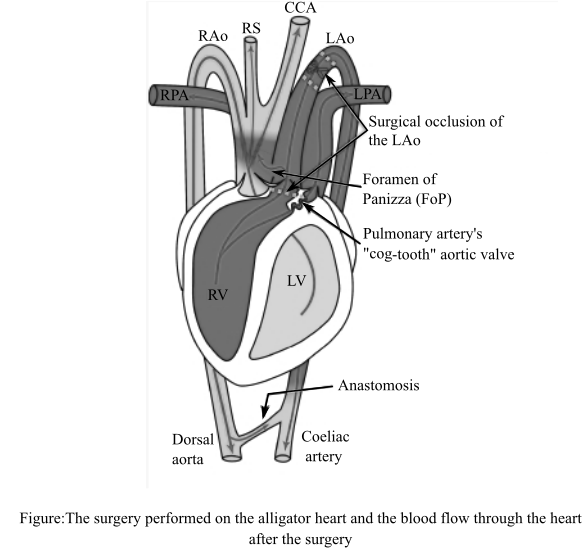
Concept explainers
To review:
The change in blood flow after the surgical removal of the pulmonary bypass shunt in alligators, with the help of a diagram, and how the surgery made the alligator heart behave like a bird heart.
Introduction:
The heart in crocodiles and alligators has four chambers, but they differ from bird hearts because they have two aortas. The two aortas are connected by a shunt known as the pulmonary bypass shunt. A surgery was performed in order to remove this shunt by closing the left aorta near the left ventricle.
Explanation of Solution
The surgery was performed and the flow of blood after the surgical removal of the pulmonary bypass shunt in alligator heart is shown in the figure below:

The diagram shows the potential flow of blood through the alligator’s heart at the time of the cardiac shunt. The blood flows from the left aorta, foramen of Panizza, and into the right aortic arch. The scissors symbol and the dotted lines in the diagram show the location at which the surgery was performed and the flow of blood to the left aorta was blocked.
After the surgical removal of the cardiac shunt, the alligator heart became similar to a bird heart. The major difference between the bird and alligator heart is that the alligator heart has two aortas, while the heart in birds has only one. The occlusion of the left aorta in alligator meant that it was only left with one functional aorta through which the blood could flow.
The right ventricle would pump blood into the lungs through the pulmonary artery and the left ventricle would pump blood to the rest of the body through the aorta.
Therefore, it can be concluded that by blocking the left aorta or by removing the pulmonary bypass shunt surgically, the alligator heart starts behaving like a bird’s heart.
Want to see more full solutions like this?
Chapter 49 Solutions
LIFE:SCIENCE OF BIOL.(LL) >CUSTOM<
- You intend to insert patched dominant negative DNA into the left half of the neural tube of a chick. 1) Which side of the neural tube would you put the positive electrode to ensure that the DNA ends up on the left side? 2) What would be the internal (within the embryo) control for this experiment? 3) How can you be sure that the electroporation method itself is not impacting the embryo? 4) What would you do to ensure that the electroporation is working? How can you tell?arrow_forwardDescribe a method to document the diffusion path and gradient of Sonic Hedgehog through the chicken embryo. If modifying the protein, what is one thing you have to consider in regards to maintaining the protein’s function?arrow_forwardThe following table is from Kumar et. al. Highly Selective Dopamine D3 Receptor (DR) Antagonists and Partial Agonists Based on Eticlopride and the D3R Crystal Structure: New Leads for Opioid Dependence Treatment. J. Med Chem 2016.arrow_forward
- The following figure is from Caterina et al. The capsaicin receptor: a heat activated ion channel in the pain pathway. Nature, 1997. Black boxes indicate capsaicin, white circles indicate resinferatoxin. You are a chef in a fancy new science-themed restaurant. You have a recipe that calls for 1 teaspoon of resinferatoxin, but you feel uncomfortable serving foods with "toxins" in them. How much capsaicin could you substitute instead?arrow_forwardWhat protein is necessary for packaging acetylcholine into synaptic vesicles?arrow_forward1. Match each vocabulary term to its best descriptor A. affinity B. efficacy C. inert D. mimic E. how drugs move through body F. how drugs bind Kd Bmax Agonist Antagonist Pharmacokinetics Pharmacodynamicsarrow_forward
- 50 mg dose of a drug is given orally to a patient. The bioavailability of the drug is 0.2. What is the volume of distribution of the drug if the plasma concentration is 1 mg/L? Be sure to provide units.arrow_forwardDetermine Kd and Bmax from the following Scatchard plot. Make sure to include units.arrow_forwardChoose a catecholamine neurotransmitter and describe/draw the components of the synapse important for its signaling including synthesis, packaging into vesicles, receptors, transporters/degradative enzymes. Describe 2 drugs that can act on this system.arrow_forward
- The following figure is from Caterina et al. The capsaicin receptor: a heat activated ion channel in the pain pathway. Nature, 1997. Black boxes indicate capsaicin, white circles indicate resinferatoxin. a) Which has a higher potency? b) Which is has a higher efficacy? c) What is the approximate Kd of capsaicin in uM? (you can round to the nearest power of 10)arrow_forwardWhat is the rate-limiting-step for serotonin synthesis?arrow_forwardWhat enzyme is necessary for synthesis of all of the monoamines?arrow_forward
 Medical Terminology for Health Professions, Spira...Health & NutritionISBN:9781305634350Author:Ann Ehrlich, Carol L. Schroeder, Laura Ehrlich, Katrina A. SchroederPublisher:Cengage Learning
Medical Terminology for Health Professions, Spira...Health & NutritionISBN:9781305634350Author:Ann Ehrlich, Carol L. Schroeder, Laura Ehrlich, Katrina A. SchroederPublisher:Cengage Learning





